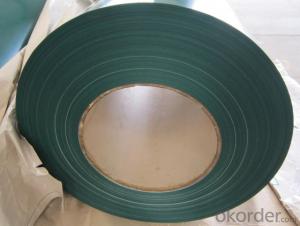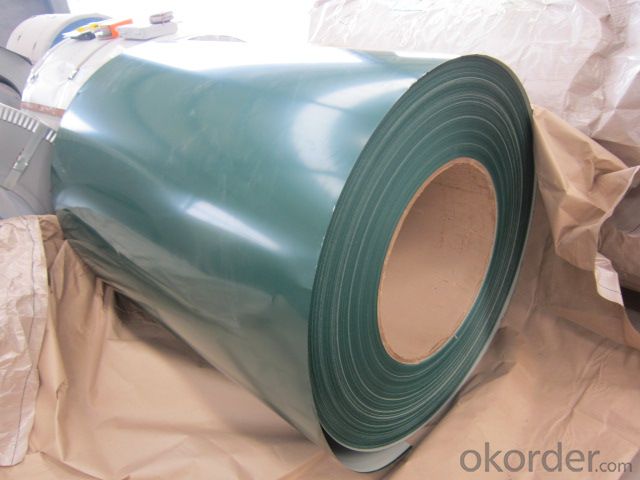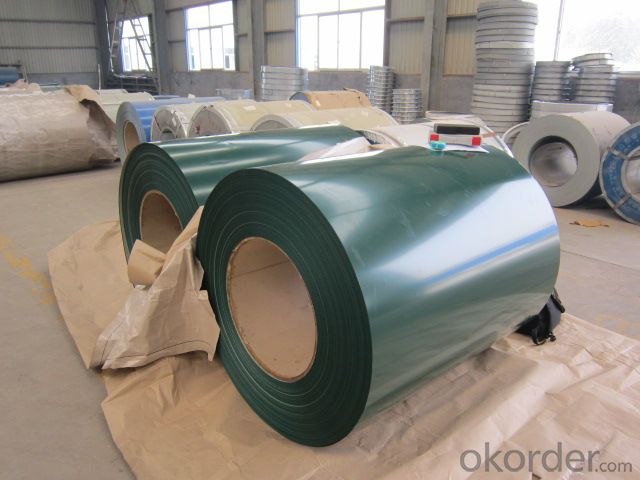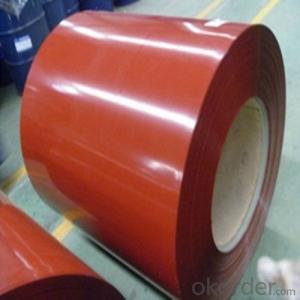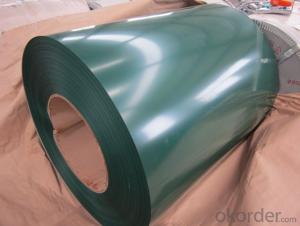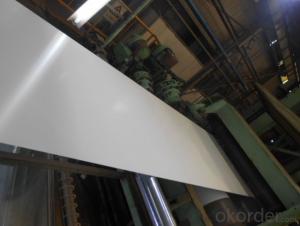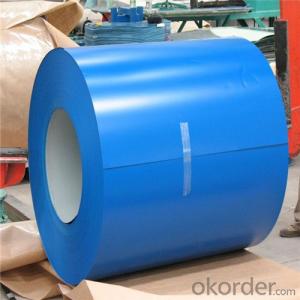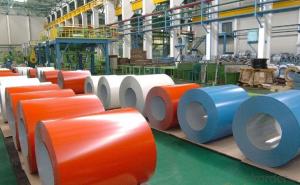Pre Painted Galvanized Steel Coil in Coils
- Loading Port:
- Tianjin
- Payment Terms:
- TT OR LC
- Min Order Qty:
- 50 m.t.
- Supply Capability:
- 5000 m.t./month
OKorder Service Pledge
OKorder Financial Service
You Might Also Like
Description:
Pre-Painted Steel Coil is coated with organic layer, which provides higher anti-corrosion property and a longer lifespan than that of galvanized steel sheets.
The Pre Painted Steel Coil can also be classified into groups by their surface textures, namely regular prepainted sheets, embossed sheets and printed sheets.
The production process has evolved from one-coating-and-one-baking to double-coating-and-double-baking, and even three-coating-and-three-baking.
The base metals for Pre Painted Steel Coil consist of cold rolled, HDG electro-galvanized and hot-dip alu-zinc coated steel. The finish coats of Pre Painted Steel Coil can be classified into groups as follows: polyester, silicon modified polyesters, polyvinylidene fluoride, high-durability polyester, etc.
Application:
It’s suitable for indoor or outdoor decoration, color lasting for at least 10 years for outdoor using, could for roll forming., conditioning, micro-wave oven, bread maker,solar water heater,condencing apparatus,Blackboard, white board,chalkboard, hidden cell blackboard,bulletin board,Central heating slice, lampshade, chifforobe, desk, bed, locker, bookshelf,garbage can, billboard, typewriter, instrument panel, weight sensor, photographic equipment,coffin, fence, Prepainted Galvanized Steel Coil
Electrical appliance:Refrigerator, washer, switch cabinet, instrument cabinet, air
Product Specification:
Color pre painted steel in coil
Thickness: 0.3-0.8mm
Width: 914-1250mm
Inner Diameter: 508mm,610MM
Weight of Steel Coil: 3-8MT
Available Dipped Layer: 50-150g/m2
Coating Type: Al-Zn Alloy
Paint: PE or PVDF
Available Surface Treatment: Passivating & Oiling & AFP & Filming
Type of coating structure: 2/1 Coat the top surface of the steel sheet twice, coat the bottom surface once, and bake the sheet twice.
Front Side Paint Thickness: 15-25μm
Back Side Paint Thickness: 5-10μm
STANDARD:JIS G3312,CGCC
FAQ:
1.Could you tell me the package for the Pre Painted Steel Coil?
Usually Standard export seaworthy package: waterproof paper+steel trip packed+wooden case seaworthy package
2.How about the color of the Pre Painted Steel Coil
The color of the Pre Painted Steel Coil has a very wide selection, like orange, cream-colored, dark sky blue, sea blue, bright red, brick red, ivory white, porcelain blue.
3. Can you produce the goods according to our requirements?
Yes, of course, it can be customized according to customer’s requirements.
Protective film can be provided according to customer if you needs.
- Q: Can't find it- this is for a physics experiment for youngs modulus done with a steel wire.
- This Site Might Help You. RE: what is the elastic limit of steel in Nm^2? Can't find it- this is for a physics experiment for youngs modulus done with a steel wire.
- Q: What is the minimum order quantity for steel coils?
- The minimum order quantity for steel coils varies depending on the supplier and specific product. It is recommended to contact the supplier directly to inquire about their minimum order requirements for steel coils.
- Q: What are the main applications of steel coils?
- The main applications of steel coils include manufacturing of automobiles, construction materials, appliances, machinery, and various industrial sectors. They are also used in the production of pipes, tubes, roofing, and packaging materials.
- Q: I am making a sword of 1060 carbon steel and would like to know how to heat treat it once it's ready, could anyone help please?
- Heat treating easy, HA! It is the most critical part of bladesmithing. Done wrong and all those hours of work go up in smoke (or a snap of the steel). You'll need a bucket of oil, preferably one that is deep enough to go in point first. If not you'll have to go in edge first, not recommended on a double edged blade, ok for single edge. You'll need to build a charcoal fire long enough for the blade. You will need to blow air under the fire to get it hot enough, the challenge is getting the heat even. You get the fire going and established, put the blade in turning it back and forth (if you keep turning it in the same direction when it heats up you could work a twist in it). When it starts turning red pull it out and touch it with a magnet, if the magnet sticks put it back. Keep heating and repeating until the magnet no longer sticks. Heat a little more, then quench rapidly point first. Don't let the blade lean to one side as warpage will occur. When it cools enough to touch, check with a file. If the doesn't file cut then you've properly hardened the steel and it's ready for temper. Now comes the really hard part. Grind the scale off carefully,preferably with a side grinder with a flap wheel. I've had hard wheel break freshly hardened blades. After cleaning you'll need to put it in an oven (preferred) or use a torch and carefully heat the blade. Watch the temper colors (oven temp 500-550F) or with the torch as the steel turns colors blue to purple for a double edged weapon. Any warpage that occurs needs to be worked out at temping temp.
- Q: What are the common size limitations for steel coils?
- The size limitations for steel coils can vary depending on the specific requirements of the industry or application. However, there are commonly followed general size limitations in the steel manufacturing and distribution industry. Steel coils can have a width ranging from as narrow as 0.25 inches (6.35 mm) to as wide as 72 inches (1828.8 mm). This wide range allows for versatility in various applications, including automotive parts and construction materials. The thickness of steel coils can vary significantly, usually ranging from 0.006 inches (0.15 mm) to 0.5 inches (12.7 mm). Thinner coils are often used when lighter weight and flexibility are required, while thicker coils are commonly used in heavy-duty applications that require strength and durability. Consideration should also be given to the weight of steel coils, especially for transportation and handling purposes. Steel coils can typically weigh anywhere from a few hundred pounds to several tons. The weight limitations depend on factors such as the size of the coil, the steel grade, and the transportation and storage equipment used. Additionally, there are limitations on the outer and inner diameter of steel coils. The outer diameter usually ranges from 24 inches (609.6 mm) to 72 inches (1828.8 mm), while the inner diameter can vary from 16 inches (406.4 mm) to 24 inches (609.6 mm). These dimensions are crucial for ensuring compatibility with processing equipment and storage racks. It is important to note that these size limitations are not fixed and can be customized based on specific requirements. Steel manufacturers and distributors often collaborate closely with their customers to determine the optimal size and dimensions of the coils, ensuring efficient handling and processing.
- Q: Can steel coils be coated with phosphorescent materials?
- Yes, steel coils can be coated with phosphorescent materials. The phosphorescent coating can be applied to the surface of the steel coils, allowing them to emit a glow in the dark or low-light conditions.
- Q: How do steel coils contribute to the manufacturing of steel furniture?
- Steel coils play a crucial role in the manufacturing of steel furniture. These coils, which are made of high-quality steel, serve as the primary raw material for the production of various furniture items. Firstly, steel coils are used to create the framework and structure of steel furniture. These coils can be easily cut, shaped, and welded into various shapes and sizes, allowing manufacturers to create sturdy and durable furniture frames. The flexibility of steel coils enables the production of furniture with intricate designs and unique shapes, providing both functional and aesthetic value. Additionally, steel coils are also used in the production of springs for furniture such as sofas and chairs. The elasticity and strength of the steel coils make them ideal for creating comfortable and supportive seating options. These coils are carefully formed and integrated into the furniture, ensuring that the seating surface provides the necessary resilience and flexibility for a comfortable experience. Moreover, steel coils contribute to the overall durability and longevity of steel furniture. Steel is known for its high tensile strength and resistance to wear and tear, making it an excellent choice for furniture that is subjected to heavy use and weight load. The use of steel coils ensures that the furniture can withstand years of regular use without compromising its structural integrity. Furthermore, steel coils are often treated with various finishes and coatings to enhance their appearance and protect them from corrosion. These coatings can be applied to the coils before they are shaped into furniture components, ensuring that the final product maintains its aesthetic appeal and remains resistant to rust and other forms of damage. In conclusion, steel coils are an essential component in the manufacturing of steel furniture. They provide the necessary strength, flexibility, and durability required to create sturdy furniture frames, comfortable seating surfaces, and long-lasting products. Without steel coils, the production of steel furniture would not be possible, and the quality and performance of the final products would be compromised.
- Q: Why are steel saucepans and tea kettles covered with copper on the outside and the bottom? what r the goals of having high-quality pans that are thick and tea kettles that are thin walled?
- The issue is heat conduction. Copper trasferrs heat rapidly and therefore ensures uniform heat around the base or sides of teh pot. The thick walls can be two different purposes. Sometimes the steel is made in layers for the purpose of providing insulation. If a pot insulates heat then the heat will transfer in a steady manner and the need for constant fuel heat is reduced. Thus, if I want to simmer and can store some of the heat in the pot itself then I know it will transfer slowly because it has to go through the layers first. Secondly, the layers will transfer heat between them allowing for uniform heating and this avoids hot spots. Wash you pots with an acid. Lemon will clean copper very nicely. If you have to scrub then heat gently and use salt or baking soda as an abrasive. With a tea kettle you do not care about heat conduction past the point of the boil. when the boil arrives the job is done.
- Q: So we all know a 1000lb steel ball will sink in water, but if you were to leave the center of the ball hollow and fill with air, if the steel ball was big enough in diameter it should float correct? What size would the steel ball need to be to float?
- specific gravity of a steel is approximately 7.82 as compared to water. so, the hollow sphere(filled with air) is having volume more by 7.82 as compared to solid sphere, then the 1000 lb hollow steel ball float in the water (Why Do Ships Float? The Greek Mathematician and inventor Archimedes lived during the 3rd century BC. According to history he was in the bath one day when he discovered the principle of buoyancy which is the reason why huge Greek ships weighing thousands of pounds could float on water. He noticed that as he lowered himself into the bath, the water displaced by his body overflowed the sides and he realised that there was a relationship between his weight and the volume of water displaced. It is said that he ran naked into the street yelling heurEka which is where we get our word eureka! (I found it), Greek heurEka I have found, from heuriskein to find. The Buoyancy Principle: Archimedes continued to do more experiments and came up with a buoyancy principle, that a ship will float when the weight of the water it displaces equals the weight of the ship and anything will float if it is shaped to displace its own weight of water before it reaches the point where it will submerge. This is kind of a technical way of looking at it. A ship that is launched sinks into the sea until the weight of the water it displaces is equal to its own weight. As the ship is loaded, it sinks deeper, displacing more water, and so the magnitude of the buoyant force continuously matches the weight of the ship and its cargo.)
- Q: What are the dimensions of steel coils used in the packaging industry?
- The dimensions of steel coils used in the packaging industry can vary depending on the specific application and requirements. However, typical dimensions for steel coils used in packaging range from 0.15 mm to 3 mm in thickness and 600 mm to 2000 mm in width. The inner diameter of the coil, known as the core, is usually around 508 mm (20 inches), although other sizes such as 610 mm (24 inches) or 762 mm (30 inches) may also be used. The outer diameter of the coil can vary depending on the weight and size of the coil, but it is commonly around 1000 mm to 2000 mm. It is important to note that these dimensions can be customized based on the specific requirements and preferences of the packaging industry.
Send your message to us
Pre Painted Galvanized Steel Coil in Coils
- Loading Port:
- Tianjin
- Payment Terms:
- TT OR LC
- Min Order Qty:
- 50 m.t.
- Supply Capability:
- 5000 m.t./month
OKorder Service Pledge
OKorder Financial Service
Similar products
Hot products
Hot Searches
Related keywords
